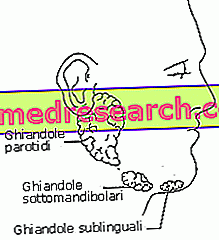See also: pH of saliva
Saliva is a hyposmotic fluid secreted by the salivary glands located in the oral cavity. Like all secretions, saliva also consists predominantly of water (99%), while only 1% is represented by inorganic and organic substances.
Among the inorganic substances, we find mainly mineral salts, in particular sodium, potassium and calcium chlorides and bicarbonates. The organic fraction is instead represented by enzymes (amylase, mucin, lysozyme) and immunoglobulins.
 | |
Salivary secretion is entrusted to different glands: 60% is produced by the submandibular glands, 30% by parotid glands and 5% by sublinguals. There are also minor salivary glands (5%). The amount of saliva produced by the parotids increases strongly following strong stimulation. The liquid secreted by the salivary glands does not always have the same characteristics: the parotid secernano saliva more fluid and rich in ptyalin; the submandibular secrete mixed saliva, while the sublinguals produce a viscous liquid, because it is rich in mucin. |
Saliva covers numerous and important functions, we see the main ones.
The digestion of food begins in the mouth, thanks to a mechanical system (chewing) assisted by chemical reactions, made possible by the presence of saliva.
This liquid transforms food into bolus (an almost uniform mixture of chopped and salted food), protecting pharynx and esophagus from any sharp or excessive food fragments.
In addition to mechanical means, saliva exerts its digestive properties through enzymes, such as lipase and salivary amylase or ptyalin . The latter begins to digest the cooked starch (the starch is a polysaccharide, present in bread, pasta, potatoes, chestnuts and other vegetable foods, consisting of many units of glucose linked together in a linear and branched way). Amylase is able to partially break the bonds within the amylaceous molecule, leading to the formation of maltose (disaccharide consisting of the union of two glucose units), maltotriose (this time there are three glucose molecules) and dextrins (7-9 units of glucose, with the presence of a branching).
Due to the reduced time the food remains in the mouth, amylase cannot digest all the starch. However, if we voluntarily chew a piece of bread for a long time, the effective digestive action of the saliva will be evidenced by the onset of a sweet taste.
Once in the stomach, the amylase associated with the bolus is inactivated by the strongly acidic environment, losing its functions. This enzyme is in fact active only in conditions of neutrality (pH 7), guaranteed by the presence in the saliva of bicarbonates, substances capable of maintaining the salivary pH close to neutrality (buffer system). The pH of saliva is less than 7 when the secretion is poor and moves towards alkalinity with increasing salivary secretion.
Amylase digests only the cooked starch, since the raw one comes in the form of granules surrounded by an indigestible wall, made up of cellulose. The cooking manages instead to elide this membrane, releasing the starch.
Saliva also has a hygienic function for the oral cavity, especially due to the presence of water and mineral salts, which pass between the teeth removing any food residues.
Saliva also has a lubricating function for the oral cavity, thanks to which it facilitates swallowing and phonation (the act of speaking). This property is linked to its mucin content, a protein which, when mixed with the water present in the saliva, takes on a viscous consistency.
The mucin goes to stratify along the walls of the oral cavity, protecting it from the abrasions of food fragments. This protein also has a protective action against the larynx and, by surrounding and lubricating the bolus, facilitates swallowing.
The mucin contained in the saliva also facilitates the phonation: if the salivation is zeroed we find it hard to speak precisely because the lubricating action of this liquid is lost. In ancient China this assumption was exploited to test the good faith of people suspected of crimes: forcing the unlucky to chew dry rice during interrogation, it was considered innocent who could produce enough saliva to swallow and guilty who, getting nervous and zeroing salivation, he could not ingest it and spoke with difficulty.
Saliva protects the body from micro-organisms introduced with food, thanks to an antibacterial agent called lysozyme, whose protective action is enhanced by the simultaneous presence of immunoglobulins (antibodies).
The salivary glands work in a continuous cycle and the saliva is secreted continuously, although it varies in quantity (1000-1500 ml per day). During sleep about 0.3 ml of saliva are secreted per minute, while when awake this quantity rises to 0.5 ml per minute. After stimulation, salivary secretion can reach 3-4 ml / minute.
The secretory stimulus is mediated by cellular mechanoreceptors, present on the walls of the oral cavity and sensitive to the presence of food (biting a pen), and chemoreceptors activated by particular chemical substances (taste buds). The signals transmitted by these receptors are conveyed to the autonomic nervous system (salivation centers located in the bulb), where they are reworked to stimulate glandular secretion. The same result is obtained when the organism is subjected to certain stimuli, such as some smells, the sight of a particularly palatable food or memories that evoke food. The whole mechanism is intended to prepare the mouth to receive food.
The efferent nerve fibers that innervate the salivary glands belong above all to the parasympathetic nervous system. However, a significant contribution is also provided by the orthosympathetic system. Both stimulate salivary secretion and this is one of the few, if not the only case, in which, simultaneously with the digestive tract, the two systems cover the same function (generally the orthosympathetic inhibits, while the sympathetic stimulates). However, there is a small difference between these regulatory mechanisms: while in normal conditions both stimulate the salivary glands, in particular situations (strong emotion or fear), the action of the orthosympathetic turns upside down and the salivary secretion is zeroed.
The lack of saliva is called xerostomia and can derive from the lesion of the salivary glands, from the use of drugs, from psychological disorders, from some diseases such as mumps (mumps) and from a general state of dehydration of the organism.
The excess of saliva is instead identified by the term "ptialism" or "sialorrhea", also due to the use of certain drugs, mental illnesses, pregnancy, the initial installation of dental prostheses, inflammatory conditions of oral cavity, excess interdental calculus and tumors affecting the first part of the digestive system.



